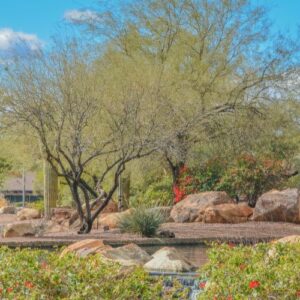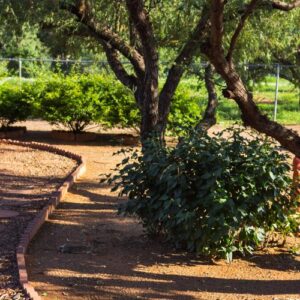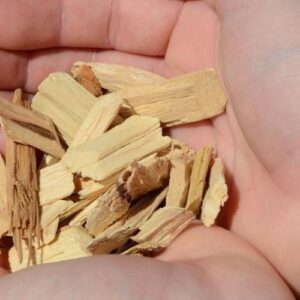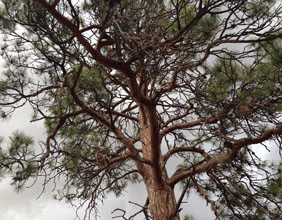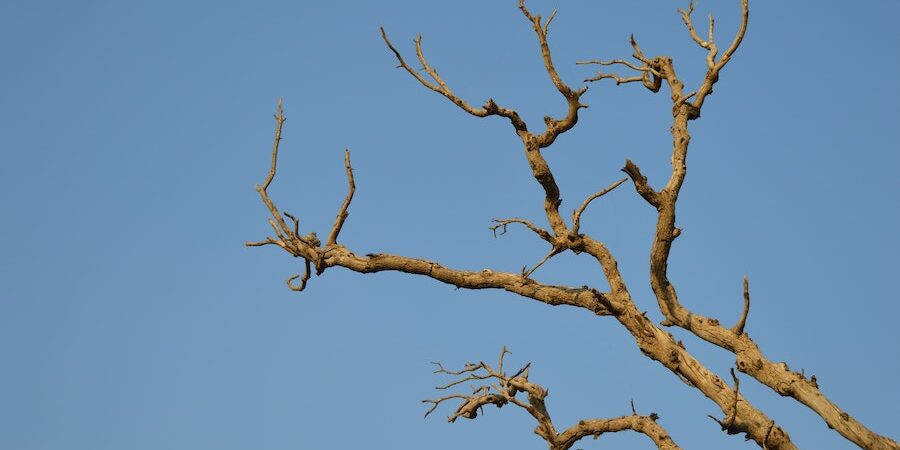
Your trees are probably infected with a fungus. How’s that for an attention-getter? But here’s the shocking part – it’s a good thing. In fact, you want to encourage this particular type of fungus to infect your trees, plants, and shrubs whenever possible.
Let’s back up a minute to explain the strange relationship that this type of fungus (called mycorrhizae) has with plants.
An Unlikely Pair
In a true example of symbiosis, plants and mycorrhizae (pronounced mi-cor-ri-zay) work together, sharing nutrients and benefits with each other. The mycorrhizae (from the Greek mykes: fungus and rhiza: root) attach themselves to a plant’s roots. They then spread out from the roots in microscopic strings, gathering moisture and nutrients that the plant itself can’t reach and/or can’t break down to use. The mycorrhizae bring these nutrients to the plant and, in return, the plant gives the fungus carbon and carbohydrates (or sugars) that it produced using photosynthesis.
As the fungi live underground, they are not able to photosynthesize and create food themselves, so this relationship benefits the mycorrhizae. Some kinds of mycorrhizae grow inside the tree roots, so the plant also protects the fungi from predators.
Fungi Extend a Plant’s Food Sources
Plants (including trees) are only able to gather nutrients from the soil up to 1/10-inch away from their roots, so they only receive the nutrients in the immediate vicinity. This means that if you water or fertilize further away from the roots than that (which you have to, there’s no way to know exactly where the roots are), the tree or plant never receives those benefits, and the effort is wasted.
With the help of mycorrhizae, plants are able to reach nutrients from a much broader area. In fact, some mycorrhizae have been discovered that connect most of a forest, sharing nutrients with the trees and plants throughout the entire area. You may have heard that scientists have discovered that trees “talk” to each other through underground webs. The mychorrizae are those webs.
Fungi Protect Against Predators and Stimulate Plant Growth
Mychorrizal fungus has always been a part of plant life, but scientists are continually finding out more about it.
Mychorrizae help protect plants against some diseases and toxins, acting as a protective barrier. As they’re better at breaking down nutrients and finding moisture in soil, they help plants be more salt and drought tolerant. This increases plant growth, and often plants and trees grow faster, healthier, and fuller when they are connected with mychorrizae.
Fungi Help Connect Plant Life
As mentioned above, the “mycorrhizal network” can connect an entire forest of plants and trees. In this way, larger trees can send nutrients to smaller seedlings to help them grow.
And it’s not just the same species that are connected. In a forest in the Pacific Northwest, scientists noted that when Douglas-fir got less sunlight to use for photosynthesis, the nearby birch trees sent the Douglas-fir trees the needed sugar via the mycorrhizae route underground. Who knew that trees also borrowed sugar from their neighbors??
The mycorrhizal network is also a way that trees warn neighboring plants of pests. In one instance, a group of Douglas-fir trees were infected with western spruce budworm. Within 24 hours, neighboring ponderosa pine trees were creating an enzyme to use as a defense against this pest – all thanks to the warning sent through the interconnected myorrhizae.
Can You See Mycorrhizae?
Though it’s estimated that 80-90% of plant life is working in tandem with mycorrhizal fungi, it’s not often seen. Most mycorrhizae are microscopically small, able to fit inside the cells of plants and between tiny dirt particles. As they continue to grow, though, the miles of thread-like mycorrhizal structures, called hyphae, can expand and sometimes you might see this hyphae connected to the roots of your plant. Note that several hundreds of miles of mycorrhizae can be contained in a tiny part of a plant.
As mychorriza is a fungus, occasionally evidence of it will show up above ground – as a mushroom! Toadstools, truffles, and chanterelles are all fruiting bodies of mychorrizae.
How Can I Ensure That my Plants and Trees are Being Helped by This Friendly Fungus?
While mycorrhizae are abundant in nature and in forest and native desert environments, it is tougher (but not impossible!) for mycorrhizae to thrive in urban and suburban environments.
Soil will have few mycorrhizae if:
- It is highly compacted (for example, in areas surrounding new construction, where heavy equipment has been on the ground, etc.)
- It is treated with high concentrations of synthetic chemicals
- It has been repeatedly tilled
- It is over infested with weeds
- It has been treated with fungicide
- Excessive fertilizer (especially phosphorus) has been applied
- Topsoil (where most mycorrhizae live) has been removed
In any of the above circumstances, trees and other plants growing in the environment will struggle to get enough nutrients to stay healthy.
To encourage mycorrhizae growth:
- Stop using soluble phosphate fertilizer, especially if you already have too much phosphate in your soil (this can be determined in a soil test)
- Don’t overwater or overfertilize your plants and trees
- Reduce pesticide use
- Coarse organic mulch (such as shredded bark and wood chips) encourages mycorrhizae growth; just be sure not to place it too close to tree trunks or plants
- Diversity of plant life encourages different types of mycorrhizae, so consider several types of plants, trees, flowers, etc. on your property
Types of mycorrhizal amendments are available commercially, and sometimes adding it to the ground when planting a tree can encourage the formation of mycorrhizal fungus partnerships, though scientists, gardeners, and arborists disagree on whether this helps or not.
While adding mycorrhizae to container gardens and nursery plants protects against root rot and encourages growth, among other things, there are arguments that adding it to native soil doesn’t do anything as there are already local strains of mycorrhizae present in the dirt.
However, each situation is different and it’s best to consult with an arborist and/or take a soil sample to determine the best course for your property.
See Our Latest Articles
More Articles Like This

Titan Tree Care is a full-service tree care company located in Anthem, AZ and serving all of North Phoenix. We offer a wide range of services to meet your tree care needs, including tree and palm trimming, tree pruning, tree removal, stump grinding, and more. We also offer insect or disease treatments and fertilization services. We are dedicated to providing high-quality, safe, and effective tree care services to our customers and work hard to ensure that your trees are healthy and look their best.



